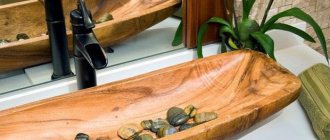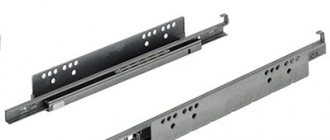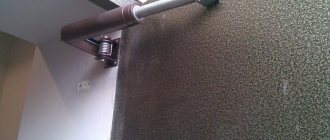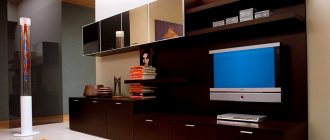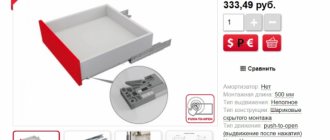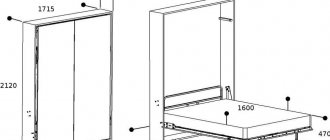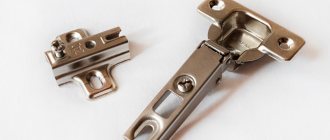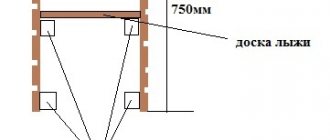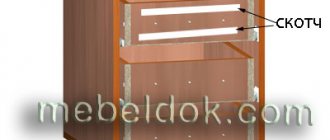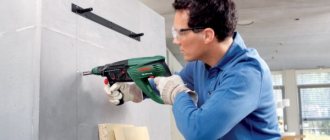Decorating the joint at the corner connection of slab materials.
Recently, corner joints of slab materials with a miter bevel have become increasingly popular in the manufacture of furniture. With such a connection, an attractive, barely visible joint is obtained, but it has a rather sharp angle, which is very unsafe, for example, when using such a connection in the manufacture of tables and headboards. Moreover, pointed, pronounced angular shapes are less practical to use - they are subject to deformation due to impacts and other mechanical influences. To avoid this, there are many ways, one of which I want to briefly share in my article.
Let's try to make an adhesive corner connection of two parts from laminated chipboard, and then smooth the resulting corner with a 45° edge cutter, followed by decorating the chamfer using available tools and materials.
We will make the cut by setting the saw at an angle of 45° to the plane of the panel being cut, having first carefully secured the guide bar of the circular saw to the part.
After cutting, we get two such neat “blanks” with which we have to carry out small operations that are quite feasible even for novice craftsmen.
Next, using an inexpensive lamella router, we will make recesses in the beveled ends of the parts for inserting flat furniture dowels (lamellas), such dowels serve to prevent the parts from shifting during connection when gluing, and also contribute to a stronger and more reliable connection.
The dowels have an oval shape and are made specifically for milling cutters with disc cutters; these cutters are very similar to the saw blade of an ordinary circular saw, only with a much smaller diameter.
Dowels are supplied in various sizes, depending on the thickness of the panel and the type of connection. The photo also shows the front side of the “sole” of the router and the saw blade (cutter) itself.
And this is what the lamellar router itself looks like. This is not an expensive model, but quite suitable for small jobs in a home workshop.
Trying on the parts to be glued.
And we apply glue to the surfaces to be glued, in this case I used Homakol glue, the brand (article) of which is more suitable for gluing sheet plastics, so it is a little “gummy” and not entirely suitable for this type of gluing, but for my example it will work quite well (laziness was to open the container with the required glue).
We connect the parts with clamps, in general it is better to use special body clamps and clamps for fastening surfaces, modifications and manufacturers of which exist in nature in quite a few (for example, the BESSEY company, the clamps of this company are located in the photo at the top), but more on this in the following publications .
We get the desired “semi-finished product”, at the junction there is visible excess glue that was squeezed out, which I did not initially remove, still there is still further work to be done to smooth out the sharp corner and the remaining glue will be removed by itself.
To remove (edge) an acute angle, we will use the cutter shown or cutters with other blade shapes and configurations.
After milling, we have something like this, it can, in principle, be painted over in any color you like, but the internal structure of the chipboard is quite porous and the paint will simply be absorbed, and the surface of the chamfer will have an uneven coating, which is very, very unattractive.
To level the surface of the laminated chipboard core, I will use the usual automotive putty that I have on hand at the time of the experiment, although it contains fiberglass, which is not very good in our case; it is advisable to use a homogeneous mass for a more uniform coverage of the cut.
We clean and degrease the places where the putty is applied, using a solvent or alcohol, but not with water-containing compounds.
And using a spatula or any other similar tool, apply a small layer of putty in order to fill all the recesses and pores of the milled surface.
Using a die on the surface of which sandpaper is glued, remove excess putty and then sand it with finer-grain sandpaper.
For painting, it is more convenient to use aerosol paint in cans, preferably acrylic, but I again used what I had on hand - inexpensive paint for household use.
We paint the edge in two or three stages and let it dry.
And for greater reliability and wear resistance, we cover the painted surface with acrylic varnish. In general, when carrying out painting work, it is always recommended to apply a protective layer of varnish to the painted products.
Cut off any varnish streaks with a utility knife. That's probably all.
Installation and removal methods
Furniture dowels make it possible to significantly increase the strength of connections. But this is not as simple a method as it might seem at first: the connection cannot be secured if any hole is displaced. Depending on the size of the offset, the result will be unsatisfactory.
As a rule, tabletops on dining tables and desks are secured with a dowel. Put them in working position like this:
- The parts are first marked on the end side, and then holes are drilled to the required depth. The same holes are made in the countertops. They must match;
- A cylindrical fastener is installed in the end hole, the upper end protrudes at a distance equal to the depth of the hole in the covering part;
- To strengthen the dowel in the hole, it is generously lubricated with glue, fixing it in the desired position. Sometimes glue is poured into the holes, where the fastener is then inserted - this will completely cover its ribbed surface with glue, improving the adhesion strength of the elements;
- The second part of the design is superimposed on the installed dowel.
There are 3 main problems in assembling furniture using dowels:
- It is possible to assemble an edge-to-edge connection, but in this case, the planes of the structural parts do not coincide. Solution: The drill guide holes were not aligned with the center edges of the parts. The device must be constantly aligned with the reference planes of the two parts being fastened. Even in the absence of a central location of holes in the connection, no shifts or sagging are formed;
- Holes in one part do not line up with another. Solution: to align the holes, use special markers designed specifically for connections. Initially, holes are made in one part with a drill. A marker is then inserted into each hole and the two pieces are pressed together as they should be when assembled. This way, the second part will have marks with markers in the places where you should drill;
- The holes are made in the right places, but the installation of the dowels is disrupted: the fasteners do not fit through or, on the contrary, fall out. Solution: It is important to make sure that the diameter of the fasteners matches the diameter of the holes. Factory fasteners are mass produced and may have a diameter slightly larger or smaller than stated. In addition, wood can swell or shrink with changes in humidity. When the diameter is verified and it is identical, then the problem is the wear of the drilling jig and, as a consequence, the deviation of the drill. This leads to deformation. It is enough to change the bushings or purchase a new device.
To correctly assemble furniture parts onto a dowel, you will need to learn three basic rules:
- To mark, use a sharp pencil or knife. A pencil with a thick lead will not make marks accurately;
- When drilling holes, you need to use drills with a central point. Twist drills with conical sharpening can deviate to the sides during work, setting the wrong direction;
- To ensure uniform hole depths, a locking ring is placed on the drill and firmly fixed. The depth of the hole is made 2 - 3 mm greater than the length of the dowel.
You can make cylindrical mounts yourself. Here is a short instruction on how to make dowels: To do this, take birch logs and split them into many pieces - you get square blanks. Next, they need to be trimmed by hand or on a lathe to give them a cylindrical shape and the required diameter. Fasteners can also be made using a circular saw.
It happens that the dowel breaks off and one half remains in the hole. The first thing you want to do is take a drill and drill out the fragment. This is incorrect, since the hole will be larger, and choosing a new mount will be more difficult.
The correct solution is to take a drill of a smaller diameter and drill in the center of the fragment. Then, using a screwdriver, chisel or chisel, break up the remaining debris and remove it from the hole. If difficulties arise, you can use photo instructions - there are a lot of them on the Internet.
Furniture connecting fittings
For the manufacture and assembly of cabinet furniture, various methods of connecting parts together are used. The type of furniture fastenings significantly affects the cost of the furniture itself, and the buyer does not pay special attention to such a detail. However, it should be noted that fastening affects the quality of the product, its service life, as well as its aesthetics.
Furniture connecting fittings vary in purpose, cost, reliability and installation complexity .
There are many types of furniture connecting fittings. We will consider only the most common connecting elements.
Furniture corner
A furniture corner is the simplest and most inexpensive way to connect cabinet and upholstered furniture. Furniture corners are used in different shapes, sizes, plastic and metal. They are very easy to install . One of the main advantages of a furniture corner is reliability .
Confirmat or screw tie, single-element fastening, one of the most reliable and at the same time inexpensive furniture connections . Resistant to mechanical stress and fracture. Installation does not require precision drilling or fixtures. For installation, a hole is drilled with a special confirmation drill having three diameters, but you can also drill with three ordinary drills of different diameters. It is used for both wooden structures and chipboards. Disadvantage is the risk of damage to the thread during repeated disassembly and assembly of furniture; it requires through drilling of parts, which violates their integrity; the head will be visible. Can be plugged for aesthetics with a plug.
How to make a blind joint on tenons using a template
1 Arrange the parts as you want them to look when connected. Label them A and B as shown above. Turn the pieces over as shown below. In this case, the surfaces are connected and look at you. Using a template and an additional clamp, tighten the pieces together so that the ends are in line.
2 Insert the brush bit into the drill. If you are tenoning a 3/4" thick board, use a 3/8" drill bit.
Advice.
To ensure you drill the holes to the correct depth, install a stopper.
3 Drill tenon holes in both pieces through the template hole. For a 3/4" thick piece, the holes in piece A should be 1.3cm deep and the holes in piece B should be 3cm deep. Move the template and drill new holes 7.5-10cm apart.
4 Check that the connection is correct by inserting 1 1/2-inch grooved tenons into A, then tapping B into place with a wooden hammer. If the parts do not fit tightly, deepen the tenon holes in part B.
5 Separate the parts and remove the tenons, apply glue to the tenons and insert them into the holes of part B. Apply glue to the surfaces to be joined. Attention. When joining melamine-coated particle boards, apply glue only to the tenons.
6 Assemble the parts by tapping them with a wooden hammer until the joint “sits” tightly. Use a damp cloth to remove excess glue.
Minifix (Eccentric coupler)
Minifix is one of the most common furniture joints. Minifix is designed for connecting furniture parts at right angles. However, there is a corner minifix that allows you to connect parts at different angles.
The minifix consists of a rod and an eccentric. Sometimes a plastic coupling is used under the rod.
Disadvantages: requires precise drilling, high price, affecting the cost of furniture.
Advantages: 1. Furniture can be assembled quickly with one screwdriver. 2. Designed for many cycles of furniture assembly and disassembly without harm to the furniture. 3. Hidden fastening, which is valuable for visible parts of furniture, such as the facade, sidewall of furniture.
How to Make Blind Face Joints Using a Tenon Center Marker
1 Mark a joining line on the front side of the workpiece. Using a template, make holes for the tenons on the edge of the other part, then insert a tenon center marker into each hole.
2 Place the pieces edge-on on a flat surface, then press them together so that the tips of the markers leave marks on the wood.
3 Drill holes at the marked points using a brush drill. For 3/4" thick wood, the holes should be 1/2" deep. Use a square drill guide with a drill stopper. Assemble the part with the spikes.
Rod (chopik, dowel)
Rod - a cylindrical wooden rod with chamfers and rounded ends. Made from hard wood or plastic. The chamfers serve for air passage when using glue, as well as for better adhesion. Reflections (chamfers) can have different patterns: straight, circular (transverse), screw. It can also be noted that the rod comes in different lengths and diameters.
The rod can be used with or without PVA glue. When using glue, such fastening is more reliable, but no longer dismountable.
The rod also serves as an additional, backup fastening when assembling furniture on minifixes.
The advantage of a dowel
Low price, simplicity, completely hidden connection.
Disadvantages of dowel
Drilling for the dowel must be extremely accurate.
Used instead of intersection screed. In order to hide the head of the screw, they are used to tighten the sections together in those places where the mounting strip of the furniture hinge will be installed or the shelf will stand.
Convenience of screeding with self-tapping screws - speed, low price
Disadvantage of self-tapping ties - weak fastening
Varieties and sizes
Such fastening is in demand in the furniture industry due to a number of advantages:
- corrugated surface - notches on the parts allow you to fix the elements well, increasing the adhesion area;
- presentability - when assembling furniture, fasteners are immersed in the base material, so they are not visible (unlike screws, bolts and other screwed-in parts);
- wide range - the consumer can choose the required length and diameter of the element depending on the design of the furniture.
There are also disadvantages, for example, such rods cannot be used if it is necessary to fasten vertical planes. For this purpose, it is better to use screws, nails and other fasteners that ensure reliable alignment. Furniture dowels can be wooden (they are more popular), as well as plastic, which are used in rare cases.
Wood
Most often, furniture is made from solid wood, MDF, plywood, chipboard. Products made from hardwood are used for its assembly. Notch options may be different:
- Straight vertical is the universal and most common type.
- Helical - located at an angle from the vertical axis, making it difficult to loosen.
- Complex - has both transverse and longitudinal cuts. Designed for structures subject to high loads that require strong connections.
- Horizontal - secures different parts as much as possible; it is not recommended for use in cases where disassembling furniture may be required.
- Smooth - made completely without corrugation, it allows you to resist the shift of structural elements due to exposure to moisture and temperature. When deformed, such a rod, also called a dowel, bends and subsequently provides high resistance to loads.
Notches on furniture dowels allow air to pass through during installation. Since wooden elements are most often placed on glue, this improves adhesion and speeds up hardening.
The assortment includes rods with a circumference from 4 to 30 mm, length sizes vary from 15 to 200 mm. They are often made to order when assembling designer items, since not every element will fit unique items. Wooden dowels are resistant to temperature changes and reliable. They have no shortcomings as such.
Plastic
The plastic version is used for connecting parts of prefabricated cabinet panel furniture, as well as for transforming products. It is produced by casting, the material used is impact-resistant plastic that does not collapse under physical impact. The options for notches on plastic dowels are the same as in the case of wooden ones. They have similar sizes. The disadvantage of this type of fastener is that it is not as common as wooden ones; it cannot be found in any department with furniture fittings.
Some plastic parts have “notch” on the sides, that is, they are equipped with protrusions. This surface prevents the dowel from falling out when disassembling furniture, securely fixing it in the main fabric.
In addition to plastic ones, there are metal dowels, which are considered stronger and last much longer. They are indispensable when assembling tables, as they provide maximum structural stability. However, such products do not prevent material shrinkage, and their cost is much higher than that of any other fastener.
Furniture ties: laying out the essence
Assembling furniture is a non-trivial task when it comes to non-standard and interesting solutions. But there are clear rules for how the elements are attached to each other. At a certain point, dowels were common, and they are still used until that time. There are other solutions for fixation, which will be discussed in the article.
Purpose
When assembling a furniture product, the location of the connected parts of the structure must be checked so that its integrity is not compromised during operation. This is what a furniture tie is intended for - a fastener that makes it possible to tightly and firmly connect structural elements located in a certain position (most often at a right angle) relative to each other. If previously furniture was assembled mainly using screws and self-tapping screws, now different types of ties are used for this.
This replacement is due to three reasons:
- Increasing the aesthetics of furniture, thanks to the use of ties, the fastening of parts becomes invisible;
- Each disassembly of furniture assembled with screws reduces reliability;
- Sometimes the use of conventional fasteners is simply impossible for structural reasons.
And finally, the use of furniture ties allows for quick and durable assembly of the product.
Design
The chrome-plated intersection tie is a detachable steel fastener made from a screw and nut in the form of a threaded cylinder. There is also a screw version with a plastic body, which has a metal nut.
Each part is equipped with special slots. They are made for fastening using any tools - keys, octagonal and hexagonal bits, various screwdrivers.
Intersectional screed is used to fasten furniture walls based on chipboard that are parallel to each other. Classic chipboard panels used to create furniture are 16 mm thick. The metal tie is long enough to connect the two walls. When fixing several chipboard panels, other types of fastening are used. The most common sizes of intersection ties are 8 and 6 mm.
